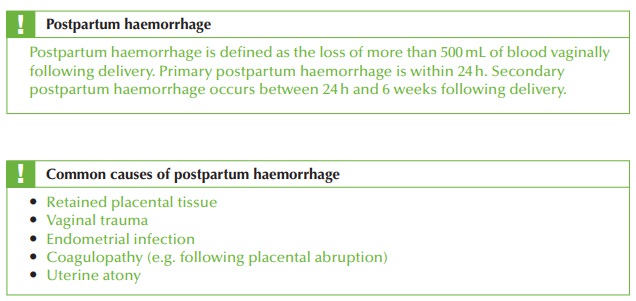Chapter: Case Study in Obstetrics and Gynaecology: Peripartum Care and Obstetric Emergencies
Case Study Reports: Postpartum Bleeding
POSTPARTUM BLEEDING
History
A
32-year-old woman is brought into the delivery
suite by ambulance
6 days following a vaginal delivery
at 39 weeks’ gestation. The pregnancy and labour had been unremark- able and the placenta was delivered by controlled cord
traction.
Following delivery the woman
had been discharged home after 6 h. She reported that the
lochia had been heavy for the first
2 days but that it had then settled to less than a period. However today she had suddenly felt crampy abdominal pain and felt a gush of fluid,
fol- lowed by very heavy bleeding. The blood has soaked through
clothes and she had passed large clots, which she describes as the size of her fist. She feels dizzy
when she stands
up and is nauseated.
Examination
She
is pale with cool and clammy extremities. She is also drowsy. Her blood pressure
is 105/50 mmHg and heart rate is 112/min. On abdominal palpation
there is minimal
tender- ness but the
uterus is palpable approximately 6 cm above the
symphysis pubis.
Speculum examination reveals large
clots of blood in the vagina. When these are removed, the cervix is seen to be
open.
Questions
·
What is the diagnosis?
·
What is your immediate
and subsequent management?
·
Should an ultrasound scan be requested?
ANSWER
The diagnosis is secondary
postpartum haemorrhage.

Immediate management
This woman is in hypovolaemic shock
and needs immediate resuscitation. Two wide-bore cannulae should be inserted
and blood sent for full blood count,
urea and electrolytes, clotting and
crossmatch of 4 units, with
further red cells,
platelets or fresh-frozen plasma requested depending on further evaluation and blood results.
Immediate intravenous fluid should
be administered, usually colloid as volume expansion to maintain cardiac
output.
The uterus should be rubbed suprapubically, and if this fails then bimanually, pending
administration of 500 μg ergometrine and
commencing a syntocinon infusion. These meas-
ures stem the blood loss and aid immediate resuscitation while the diagnosis
is investigated.
A
urinary catheter should be inserted
to allow close fluid balance
monitoring and renal function.
The anaesthetist and senior obstetrician
should be called urgently.
Subsequent management
The
fact that the cervix is open is pathognomonic of retained tissue,
and evacuation of retained products of conception should be arranged
once the woman has been resuscitated
and blood is available.
In
view of the
haemodynamic instability, general
anaesthetic is preferred. Intravenous antibiotics
should be given.
The
woman should be monitored initially in a high-dependency setting until clinically and haematologically stable.
Although she is likely to have had a coagulopathy at admission, she is still at high risk of venous
thromboembolism as she is probably septic, postpartum and has undergone
anaesthetic. Thromboembolic stockings and heparin should therefore be administered postoperatively.
Ultrasound scan
Ultrasound scan would not be indicated
in this scenario. First, an open cervix implies
retained products and
it would therefore be superfluous. Second,
an examination under anaesthetic is warranted anyway
to establish any
other cause of bleeding, such
as vaginal or perineal
trauma. Third, retained
products may be confused with blood clot on post- partum ultrasound.

Related Topics